

Compact Muon Solenoid
LHC, CERN
| CMS-PAS-EXO-17-017 | ||
| Search for physics beyond the standard model in the high-mass diphoton spectrum at 13 TeV | ||
| CMS Collaboration | ||
| May 2018 | ||
| Abstract: A search is performed for physics beyond the standard model in high-mass diphoton events from proton-proton collisions at $\sqrt{s} = $ 13 TeV, using data corresponding to an integrated luminosity of 35.9 fb$^{-1}$, delivered in 2016 to the CMS detector by the CERN Large Hadron Collider. Both resonant and nonresonant new physics signatures are searched for, using different techniques to estimate the background. Constraints are placed on the mass of the first graviton excitation in the Randall-Sundrum warped extra dimension model in the range of 2 to 4 TeV, for values of the associated coupling parameter between 0.01 and 0.2. Limits on the production of scalar resonances and model-independent fiducial cross section upper limits are also provided. For the large extra dimension model of Arkani-Hamed, Dimopoulos, and Dvali, lower limits are set on the ultraviolet cutoff scale $M_S$ ranging from 5.6 to 9.7 TeV, depending on the model parameters. Limits are also set on the continuum clockwork mechanism. | ||
|
Links:
CDS record (PDF) ;
inSPIRE record ;
CADI line (restricted) ;
These preliminary results are superseded in this paper, PRD 98 (2018) 092001. The superseded preliminary plots can be found here. |
||
| Figures & Tables | Summary | Additional Figures | References | CMS Publications |
|---|
| Figures | |

png pdf |
Figure 1:
The product of event selection efficiency and detector acceptance is shown as a function of the signal resonance mass $m_X$ for the $ {\Gamma / m} =1.4\times 10^{-4}$ signal width hypothesis. The total (black), EBEB (red) and EBEE (blue) curves are shown for the spin (J) hypotheses $\mathrm {J}=$ 0 and $\mathrm {J}= $ 2. |

png pdf |
Figure 2:
Observed invariant mass spectra for the EBEB (left) and EBEE (right). The results of a likelihood fit to the background-only hypothesis are also shown. The shaded regions show the 1 and 2 standard deviation uncertainty bands associated with the fit, and reflect the statistical uncertainty of the data. The lower panels show the difference between the data and fit, divided by the statistical uncertainty in the data points. |
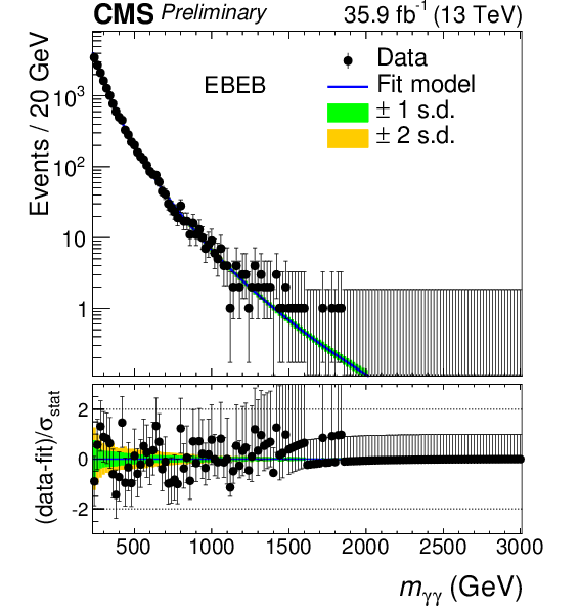
png pdf |
Figure 2-a:
Observed invariant mass spectra for the EBEB. The results of a likelihood fit to the background-only hypothesis are also shown. The shaded regions show the 1 and 2 standard deviation uncertainty bands associated with the fit, and reflect the statistical uncertainty of the data. The lower panel shows the difference between the data and fit, divided by the statistical uncertainty in the data points. |
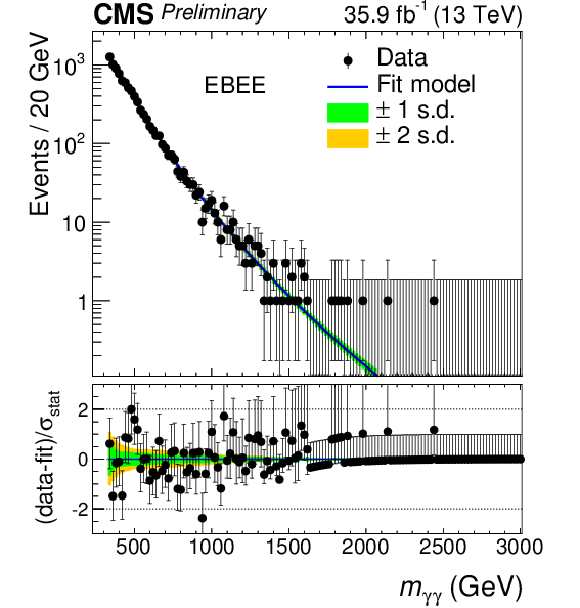
png pdf |
Figure 2-b:
Observed invariant mass spectra for the EBEE. The results of a likelihood fit to the background-only hypothesis are also shown. The shaded regions show the 1 and 2 standard deviation uncertainty bands associated with the fit, and reflect the statistical uncertainty of the data. The lower panel shows the difference between the data and fit, divided by the statistical uncertainty in the data points. |

png pdf |
Figure 3:
Expected and observed upper limits for RS graviton (left) and gluon-fusion-produced spin-0 (right) resonances of the three width hypotheses considered in the analysis. |

png pdf |
Figure 3-a:
Expected and observed upper limits |
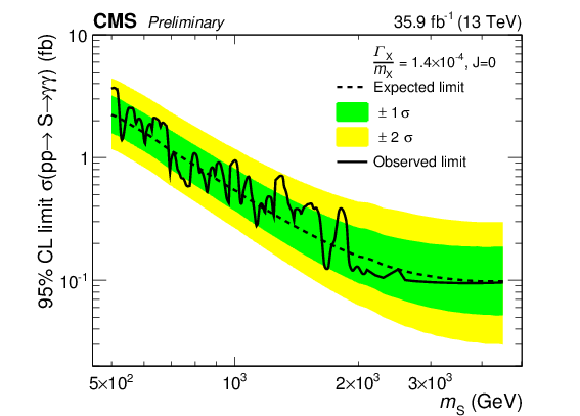
png pdf |
Figure 3-b:
Expected and observed upper limits for the gluon-fusion-produced spin-0 in the $\Gamma_{X}/m_{X} = 1.4{\times}10^{-4}$ hypothesis. |

png pdf |
Figure 3-c:
Expected and observed upper limits for the RS graviton resonance in the $\tilde{\kappa} = $ 0.1 hypothesis. |

png pdf |
Figure 3-d:
Expected and observed upper limits for the gluon-fusion-produced spin-0 in the $\Gamma_{X}/m_{X} = 1.4{\times}10^{-2} $ hypothesis. |

png pdf |
Figure 3-e:
Expected and observed upper limits for the RS graviton resonance in the $\tilde{\kappa} = $ 0.2 hypothesis. |

png pdf |
Figure 3-f:
Expected and observed upper limits for the gluon-fusion-produced spin-0 in the $\Gamma_{X}/m_{X} = 5.6{\times}10^{-2}$ hypothesis. |

png pdf |
Figure 4:
Expected and observed upper limits on the fiducial cross section for the resonant $ {\mathrm {p}} {\mathrm {p}}\to \gamma \gamma $ process. EBEB category (left) and EBEE category (right) for the three width hypotheses. |

png pdf |
Figure 4-a:
Expected and observed upper limits on the fiducial cross section for the resonant $ {\mathrm {p}} {\mathrm {p}}\to \gamma \gamma $ process. EBEB category for the $\Gamma_{X}/m_{X} = 1.4{\times}10^{-4}$ width hypothesis. |

png pdf |
Figure 4-b:
Expected and observed upper limits on the fiducial cross section for the resonant $ {\mathrm {p}} {\mathrm {p}}\to \gamma \gamma $ process. EBEE category for the $\Gamma_{X}/m_{X} = 1.4{\times}10^{-4}$ width hypothesis. |

png pdf |
Figure 4-c:
Expected and observed upper limits on the fiducial cross section for the resonant $ {\mathrm {p}} {\mathrm {p}}\to \gamma \gamma $ process. EBEE category for the $\Gamma_{X}/m_{X} = 1.4{\times}10^{-2}$ width hypothesis. |
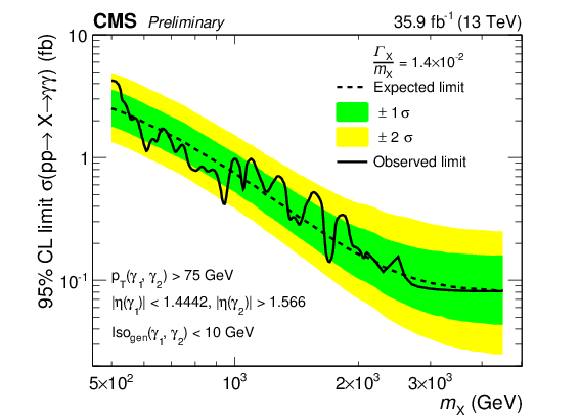
png pdf |
Figure 4-d:
Expected and observed upper limits on the fiducial cross section for the resonant $ {\mathrm {p}} {\mathrm {p}}\to \gamma \gamma $ process. EBEB category for the $\Gamma_{X}/m_{X} = 1.4{\times}10^{-2}$ width hypothesis. |

png pdf |
Figure 4-e:
Expected and observed upper limits on the fiducial cross section for the resonant $ {\mathrm {p}} {\mathrm {p}}\to \gamma \gamma $ process. EBEB category for the $\Gamma_{X}/m_{X} = 5.6{\times}10^{-2}$ width hypothesis. |

png pdf |
Figure 4-f:
Expected and observed upper limits on the fiducial cross section for the resonant $ {\mathrm {p}} {\mathrm {p}}\to \gamma \gamma $ process. EBEE category for the $\Gamma_{X}/m_{X} = 5.6{\times}10^{-2}$ width hypothesis. |
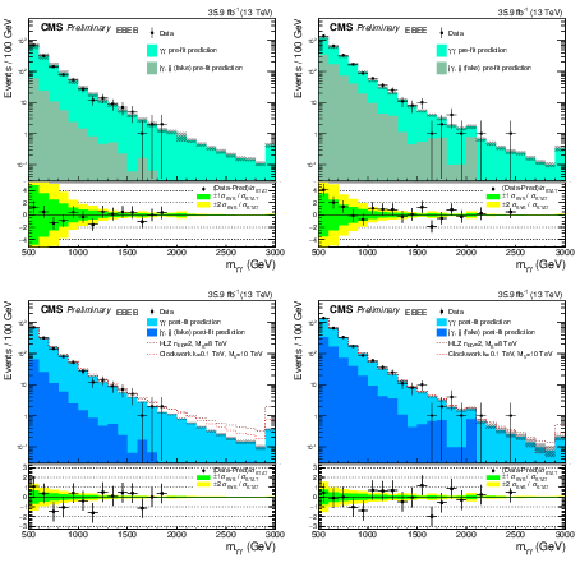
png pdf |
Figure 5:
Top: the diphoton background pre-fit predictions (computed by MCFM at NNLO) and the fake background compared to the data. Statistical and pre-fit systematic uncertainties are shown on points and as hatched band respectively. Bottom: the ${m_{\gamma \gamma}}$ posterior backgound estimate (after integrating out all nuisance parameters) are shown in filled histograms. The total post-fit systematic uncertainties are shown in hatched band. Different signal scenarios are superimposed as well. The pull distributions showing the difference between data and the background prediction, divided by the uncertainty on the background, are shown underneath each histogram, with the error bars representing the statistical uncertainties and the green(yellow) band showing the $ \pm $1$ \sigma $($ \pm $2$ \sigma $) post-fit systematic uncertainty. |

png pdf |
Figure 5-a:
The diphoton background pre-fit predictions (computed by MCFM at NNLO) and the fake background compared to the data. Statistical and pre-fit systematic uncertainties are shown on points and as hatched band respectively. The pull distributions showing the difference between data and the background prediction, divided by the uncertainty on the background, are shown underneath each histogram, with the error bars representing the statistical uncertainties and the green(yellow) band showing the $ \pm $1$ \sigma $($ \pm $2$ \sigma $) post-fit systematic uncertainty. |

png pdf |
Figure 5-b:
The ${m_{\gamma \gamma}}$ posterior backgound estimate (after integrating out all nuisance parameters) are shown in filled histograms. The total post-fit systematic uncertainties are shown in hatched band. Different signal scenarios are superimposed as well. The pull distributions showing the difference between data and the background prediction, divided by the uncertainty on the background, are shown underneath each histogram, with the error bars representing the statistical uncertainties and the green(yellow) band showing the $ \pm $1$ \sigma $($ \pm $2$ \sigma $) post-fit systematic uncertainty. |

png pdf |
Figure 6:
The exclusion limit for the continuous graviton model in the clockwork framework over the $k$-$M_5$ parameter space. The shaded region denotes where the theory becomes nonperturbative. |
| Tables | |

png pdf |
Table 1:
Exclusion lower limits obtained on the mass scale $M_S$ (in units of TeV) for various conventions used in the calculation of the ADD large extra dimension scenario. Total asymmetric uncertainties are also shown. |
| Summary |
|
A search has been performed for physics beyond the standard model in high-mass diphoton events from proton-proton collisions at a center-of-mass energy of 13 TeV. The data used corresponds to an integrated luminosity of 35.9 fb$^{-1}$ collected by the CMS detector in 2016. A resonant peak in the diphoton invariant mass spectrum could indicate the existence of a new scalar particle such as a heavy Higgs, or of a Kaluza-Klein excitation of the graviton in the Randall-Sundrum model of warped extra dimensions. A nonresonant excess could be a signature of large extra dimensions, in the ADD scenario, or the continuum clockwork model. The data are found to be in agreement with the predicted background from SM sources, and no evidence for new physics is seen. Masses below 2.0-4.35 TeV are excluded at 95% CL for the excited state of the RS graviton, for a coupling parameter in the range 0.01 $ < \tilde{k} < $ 0.2. Limits are also set on the production of scalar resonances, and model-independent fiducial cross section limits have been extracted as a function of the diphoton invariant mass for any resonant $\gamma \gamma$ production process. These results extend the sensitivity of the previous search performed with the CMS experiment [14] and are compatible with those reported by the ATLAS Collaboration in Ref. [13]. In the large extra dimension scenario, exclusion limits on the mass scale are set in the range 5.6 $ < M_S < $ 9.7 TeV, depending on the specific model convention. These results extend the current best lower limits on $M_S$ as presented in Ref. [13]. The first exclusion limits are also set in the two-dimensional parameter space of the continuum clockwork model. |
| Additional Figures | |

png pdf |
Additional Figure 1:
The product of event selection efficiency and detector acceptance is shown as a function of the signal resonance mass $m_{\mathrm{X}}$ for the $\Gamma / m=1.4\times 10^{-2}$ signal width hypothesis. The total (black), EBEB (red) and EBEE (blue) curves are shown for the spin (J) hypotheses $\mathrm {J}=$ 0 and $\mathrm {J}=$ 2. |

png pdf |
Additional Figure 2:
The product of event selection efficiency and detector acceptance is shown as a function of the signal resonance mass $m_{\mathrm{X}}$ for the $\Gamma / m=5.6\times 10^{-2}$ signal width hypothesis. The total (black), EBEB (red) and EBEE (blue) curves are shown for the spin (J) hypotheses $\mathrm {J}=$ 0 and $\mathrm {J}=$ 2. |
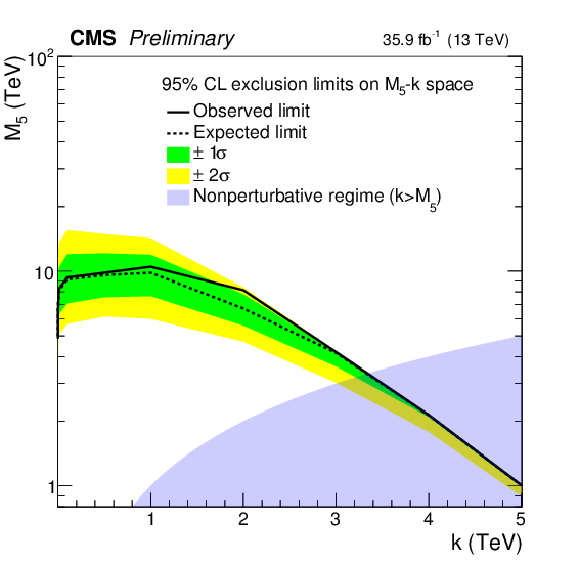
png pdf |
Additional Figure 3:
The exclusion limit for the continuous graviton model in the clockwork framework over the $k$-$M_5$ parameter space using a linear $k$-axis scale. The shaded region denotes where the theory becomes nonperturbative. |

png pdf |
Additional Figure 4:
An event display of the highest invariant mass diphoton event recorded in 2016 at 1840 GeV in the EBEB category. The two photons are represented by the red ECAL energy deposits. |
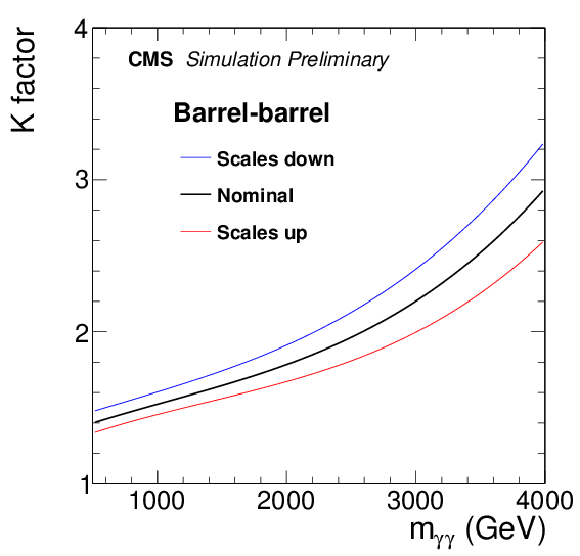
png pdf |
Additional Figure 5:
The NNLO $K$ factor for the $m_{\gamma \gamma}$ distribution in the EBEB category. The renormalization and factorization scales have been set to $m_{\gamma \gamma}$ and simultaneously varied by 0.5 (blue), 1.0 (black), and 2.0 (red). |

png pdf |
Additional Figure 6:
The NNLO $K$ factor for the $m_{\gamma \gamma}$ distribution in the EBEE category. The renormalization and factorization scales have been set to $m_{\gamma \gamma}$ and simultaneously varied by 0.5 (blue), 1.0 (black), and 2.0 (red). |
| References | ||||
| 1 | N. Arkani-Hamed, S. Dimopoulos, and G. Dvali | The hierarchy problem and new dimensions at a millimeter | PLB 429 (1998) 263 | hep-ph/9803315 |
| 2 | L. Randall and R. Sundrum | A large mass hierarchy from a small extra dimension | PRL 83 (1999) 3370 | hep-ph/9905221 |
| 3 | G. F. Giudice and M. McCullough | A clockwork theory | JHEP 02 (2017) 036 | 1610.07962 |
| 4 | I. Antoniadis, S. Dimopoulos, and A. Giveon | Little string theory at a TeV | JHEP 05 (2001) 055 | hep-th/0103033 |
| 5 | I. Antoniadis, A. Arvanitaki, S. Dimopoulos, and A. Giveon | Phenomenology of TeV little string theory from holography | PRL 108 (2012) 081602 | 1102.4043 |
| 6 | K. Choi and S. H. Im | Realizing the relaxion from multiple axions and its UV completion with high scale supersymmetry | JHEP 01 (2016) 149 | 1511.00132 |
| 7 | D. E. Kaplan and R. Rattazzi | Large field excursions and approximate discrete symmetries from a clockwork axion | PRD 93 (2016) 085007 | 1511.01827 |
| 8 | M. Baryakhtar | Graviton phenomenology of linear dilaton geometries | PRD 85 (2012) 125019 | 1202.6674 |
| 9 | G. F. Giudice et al. | Clockwork / linear dilaton: Structure and phenomenology | 1711.08437 | |
| 10 | G. C. Branco et al. | Theory and phenomenology of two-Higgs-doublet models | PR 516 (2012) 1 | 1106.0034 |
| 11 | T. D. Lee | A theory of spontaneous $ T $ violation | PRD 8 (1973) 1226 | |
| 12 | N. Craig, J. Galloway, and S. Thomas | Searching for signs of the second Higgs doublet | 1305.2424 | |
| 13 | ATLAS Collaboration | Search for new phenomena in high-mass diphoton final states using 37 fb$ ^{-1} $ of proton--proton collisions collected at $ \sqrt{s}= $ 13 TeV with the ATLAS detector | PLB 775 (2017) 105 | 1707.04147 |
| 14 | CMS Collaboration | Search for high-mass diphoton resonances in proton-proton collisions at 13 TeV and combination with 8 TeV search | PLB 767 (2017) 147 | CMS-EXO-16-027 1609.02507 |
| 15 | ATLAS Collaboration | Search for resonances in diphoton events at $ \sqrt{s} = $ 13 TeV with the ATLAS detector | JHEP 09 (2016) 001 | 1606.03833 |
| 16 | CMS Collaboration | Search for resonant production of high-mass photon pairs in proton-proton collisions at $ \sqrt{s}= $ 8 and 13 TeV | PRL 117 (2016) 051802 | CMS-EXO-16-018 1606.04093 |
| 17 | ATLAS Collaboration | Search for high-mass diphoton resonances in $ pp $ collisions at $ \sqrt{s}= $ 8 TeV with the ATLAS detector | PRD 92 (2015) 032004 | 1504.05511 |
| 18 | CMS Collaboration | Search for diphoton resonances in the mass range from 150 to 850~GeV in pp collisions at $ \sqrt{s} = $ 8 TeV | PLB 750 (2015) 494 | CMS-HIG-14-006 1506.02301 |
| 19 | ATLAS Collaboration | Search for Extra Dimensions in diphoton events using proton-proton collisions recorded at $ \sqrt{s}= $ 7 TeV with the ATLAS detector at the LHC | New J. Phys. 15 (2013) 043007 | 1210.8389 |
| 20 | CMS Collaboration | Search for signatures of extra dimensions in the diphoton mass spectrum at the Large Hadron Collider | PRL 108 (2012) 111801 | CMS-EXO-11-038 1112.0688 |
| 21 | CDF Collaboration | Search for new dielectron resonances and Randall-Sundrum gravitons at the Collider Detector at Fermilab | PRL 107 (2011) 051801 | 1103.4650 |
| 22 | D0 Collaboration | Search for Randall-Sundrum gravitons in the dielectron and diphoton final states with 5.4 fb$ ^{-1} $ of data from $ p\bar{p} $ collisions at $ \sqrt{s}= $ 1.96 TeV | PRL 104 (2010) 241802 | 1004.1826 |
| 23 | CMS Collaboration | Performance of photon reconstruction and identification with the CMS detector in proton-proton collisions at $ \sqrt{s} = $ 8 TeV | JINST 10 (2015) P08010 | CMS-EGM-14-001 1502.02702 |
| 24 | CMS Collaboration | The CMS trigger system | JINST 12 (2017) P01020 | CMS-TRG-12-001 1609.02366 |
| 25 | CMS Collaboration | The CMS experiment at the CERN LHC | JINST 3 (2008) S08004 | CMS-00-001 |
| 26 | CMS Collaboration | Particle-flow reconstruction and global event description with the CMS detector | JINST 12 (2017) P10003 | CMS-PRF-14-001 1706.04965 |
| 27 | CMS Collaboration | Observation of the diphoton decay of the Higgs boson and measurement of its properties | EPJC 74 (2014) 3076 | CMS-HIG-13-001 1407.0558 |
| 28 | CMS Collaboration | First results on Higgs to $ \gamma\gamma $ at 13 TeV | CMS-PAS-HIG-15-005 | CMS-PAS-HIG-15-005 |
| 29 | T. Gleisberg et al. | Event generation with SHERPA 1.1 | JHEP 02 (2009) 007 | 0811.4622 |
| 30 | J. Gao et al. | CT10 next-to-next-to-leading order global analysis of QCD | PRD 89 (2014) 033009 | 1302.6246 |
| 31 | T. Gleisberg et al. | Helicity formalism for spin-2 particles | JHEP 0309 (2003) 001 | hep-ph/0306182 |
| 32 | G. F. Giudice, R. Rattazzi, and J. D. Wells | Quantum gravity and extra dimensions at high-energy colliders | NPB 544 (1999) 3 | hep-ph/9811291 |
| 33 | T. Han, J. D. Lykken, and R.-J. Zhang | On Kaluza-Klein states from large extra dimensions | PRD 59 (1999) 105006 | hep-ph/9811350 |
| 34 | J. L. Hewett | Indirect collider signals for extra dimensions | PRL 82 (1999) 4765 | hep-ph/9811356 |
| 35 | GEANT4 Collaboration | GEANT4---a simulation toolkit | NIMA 506 (2003) 250 | |
| 36 | T. Sjostrand et al. | An introduction to PYTHIA 8.2 | CPC 191 (2015) 159 | 1410.3012 |
| 37 | R. D. Ball et al. | Parton distributions with LHC data | NPB 867 (2013) 244 | 1207.1303 |
| 38 | CMS Collaboration | Event generator tunes obtained from underlying event and multiparton scattering measurements | EPJC 76 (2016) 155 | CMS-GEN-14-001 1512.00815 |
| 39 | S. Hoeche, S. Schumann, and F. Siegert | Hard photon production and matrix-element parton-shower merging | PRD 81 (2010) 034026 | 0912.3501 |
| 40 | J. M. Campbell, R. K. Ellis, Y. Li, and C. Williams | Predictions for diphoton production at the LHC through NNLO in QCD | JHEP 07 (2016) 148 | 1603.02663 |
| 41 | T. Binoth, J. P. Guillet, E. Pilon, and M. Werlen | A full next-to-leading order study of direct photon pair production in hadronic collisions | EPJC 16 (2000) 311 | hep-ph/9911340 |
| 42 | A. L. Read | Presentation of search results: The CL$ _{\text{s}} $ technique | JPG 28 (2002) 2693 | |
| 43 | T. Junk | Confidence level computation for combining searches with small statistics | NIMA 434 (1999) 435 | hep-ex/9902006 |
| 44 | ATLAS and L. CMS Collaborations | Procedure for the LHC Higgs boson search combination in Summer 2011 | CMS-NOTE-2011-005 | |
| 45 | G. Cowan, K. Cranmer, E. Gross, and O. Vitells | Asymptotic formulae for likelihood-based tests of new physics | EPJC 71 (2011) 1554 | 1007.1727 |

|
Compact Muon Solenoid LHC, CERN |

|

|

|

|

|

|